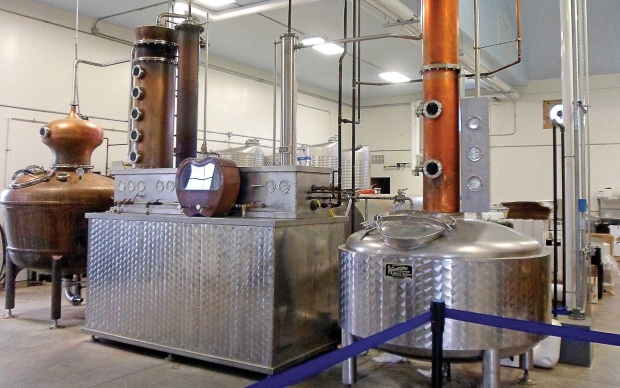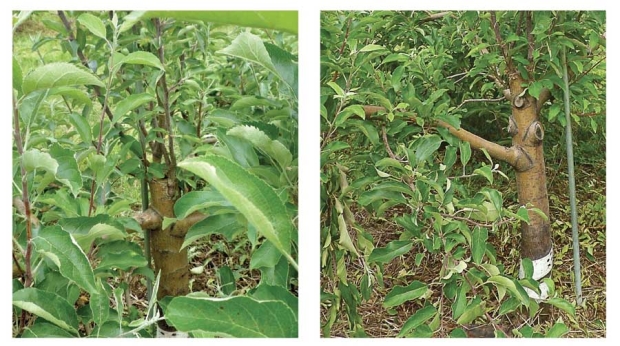
Distilled hard apple cider products—applejack, brandies, and vodkas—fetch good prices. (Richard Lehnert/Good Fruit Grower)
It is said that Californians change fruit varieties as freely as other growers change socks.
Topworking trees to keep the roots and shift to different varieties is far less widely practiced in the East than it is in the West, but at DeFisher Fruit Farms in Williamson, New York, Dave DeFisher uses side grafting and cleft grafting to transform orchards.
While Dave and his father, Bill, still primarily produce apples for processing, they have topworked orchards to change from less desirable processing varieties to better ones, to change from processing varieties to fresh market ones, and now they are changing orchards to incorporate more hard cider varieties, as cider demand is booming and specialty hard cider trees are difficult to find.
During the Lake Ontario Summer Fruit Tour in June, DeFisher’s message to visiting growers was, think before you push those older blocks. Not only can you capture the benefits of existing roots, you should think twice before taking out some older varieties. Many older varieties that are out of favor for fresh or processing fit very well into the hard cider world.
In 2012, the DeFishers opened Apple Country Spirits and went into business selling distilled spirits and hard apple cider from the fruit they were already growing on the farm. On a shelf inside, Applejack, an aged bourbon-like product, was selling at Jack Daniels’ prices, $43 a bottle.

Visitors can view the still from a window in the tasting room. (Richard Lehnert/Good Fruit Grower)
Several Cornell University specialists were in the orchards during the tour to speak about some of the methods and benefits of topworking.
Mario Miranda Sazo, the Lake Ontario Fruit Programs cultural practices educator, noted that planting an orchard can entail two to three years of soil preparation followed by two to three years’ growing time before much production is achieved, whereas topworked orchards can produce fruit the year after grafting.
Not attractive

New shoots grow from a cleft graft, keeping the rootstock and changing the tree to a more desireable hard cider variety. Dave DeFisher leaves “draw limbs” below the site of the graft. (Richard Lehnert/Good Fruit Grower)
Matt Wells, who replaced Alison DeMarree as Cornell’s production economics and business management educator, said that grafting is a quick way to convert an orchard, assuming the grower is happy with the existing rootstock and spacing.
Topworked orchards are “not attractive,” he said, but the cost is lower.
Instead of paying $8 for a whole new tree, it costs 50 to 75 cents for each stick grafted, and it takes only one on a small tree or about three on a tree four inches or so in diameter. The “power” in the established root propels swift growth.
DeFisher said he uses two different grafting styles, depending in part on the size of the existing root. On the larger ones, he cuts the tree off, leaving two or three scaffold limbs at the bottom to serve as “draw limbs” pulling water and nutrients.
He grafts about three of the new scion sticks, each about six inches long, around the edge of the cut stump. Cleft grafting matches the cambium layers on the two. He uses a small bamboo stake to support the shoot until the new graft union is strong.
When the graft shoots are established, he will choose one to be the central leader and either remove extra shoots or bend them down into scaffold positions.
On smaller trees, he uses a side graft. The new scion shoot is grafted into the leader. When it becomes established, the original leader for the older variety is cut off above the new graft.
Hard cider
Retired Cornell horticulturist Dr. Ian Merwin spoke about hard cider varieties. He has pursued the cider business more passionately since he retired. His Black Diamond Farm contains French and English varieties that are traditional hard cider apples, but he encourages growers to look carefully at what they already grow.
Hard cider consumption in the United States has been doubling every two years since the year 2000, he said, and the number of cideries in New York has grown from 6 to 60. Regulatory barriers have come down, and demand for cider apples is soaring.
While cider apples are classified into four types—sweets, sharps, bittersweets, and bittersharps—and some are “treasured” as cider apples, the growing U.S. market has not hardened into rigid styles. “There are no rules, and very few cider snobs,” Merwin said.
Growers need to decide what not to take out when evaluating orchards that are growing less-than-modern or less-than-desirable varieties.
That means growers can use many of the varieties they are already growing. Desirable varieties, especially the European ones with great names like Brown Snout and Foxwhelp, sell for $400 a bin—field run, sometimes even as drops or apples shaken to the ground and picked up.
Because of the shortage of rootstocks, Merwin thinks topworking makes sense. Cider variety scion wood is often cut from older orchards and may not be virus free, he said.
The DeFishers grow fruit mainly for processing. They grow apples, pears, peaches, cherries, plums, and some fresh-market berries and sell them to several different processors. But they look for markets that will return a higher value. Now, they have diverted a large portion of their apples to the hard cider and distilled spirits market.
Their flagship product is called Tree Vodka, made 100 percent from their apples. They sell flavored versions using their own raspberries and peaches. “Our new hard cider brand is called Rootstock Ciderworks, aptly named for the existing rootstocks we have kept and repurposed to feed the topworked trees that are now providing wonderful apples for cider use,” DeFisher said.
Tasting room

Set up for an event, the tasting room was build of a combination of old barn beams and high quality hardwood lumber cut from the farm. (Courtesy Apple Country Spirits)
When their century-old barn blew down in 2012, they built their tasting barn using hand-hewn beams and reclaimed wood along with cherry and walnut wood grown on the farm to provide a rich red interior.
The tasting room features large windows from which the entire operation—cider press, fermentation tanks, aging barrels, and stills— can be seen in operation, under the direction of distiller Collin McConville.
Distilling fruit spirits requires some skill, McConville said, because fermented fruit contains some poisonous methyl alcohol, as well as ethyl alcohol, the drinking kind, and some other alcohols as well.
The idea in distilling is to use the various boiling points of the different alcohols to separate out the desirable ethanol and retain desirable flavors and aromas. •
– by Richard Lehnert






Leave A Comment